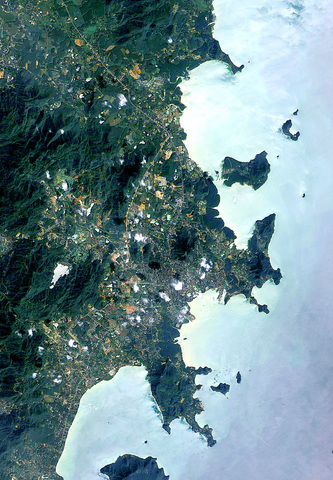Taiwan-produced quality satellite imagery has been in great demand by countries affected by the earthquake-generated tsunami, because Taiwan's second satellite, officially known as ROCSAT-2, is the only satellite able to take pictures of disaster areas every day, the National Space Program Office (NSPO) said yesterday.
The satellite, nicknamed FORMOSAT-2, can produce images of objects as small as 2m across, and orbits the planet 14 times a day, passing over areas affected by the tsunami twice a day. Since Dec. 28, the satellite has been conducting a special operation to take pictures of the most-seriously affected areas in South Asia.

PHOTO: AP/NSPO
"The satellite is the only one that can visit the area daily. Thus, we can conduct observations more frequently than others," Lance Wu (
Although other satellite images, such as those produced by IKONOS, have better resolution -- about 1m -- the satellites that produce them only pass the affected areas once every two or three days, Wu said.
"So far, images from the disaster area covering about 100,000km2 have been taken. The mission will continue for several weeks, in order to build a useful database for future geographic and ecological analysis," Wu said.
According to Wu, several seriously affected areas, such as Banda Aceh, Phuket, the Andaman Islands and the Maldives had been imaged consecutively. The images have been available free-of-charge on the NSPO Web site, and more than 60 countries have downloaded what they needed.
"Several affected countries, such as Thailand and Indonesia, even requested us to take pictures of specific coastal areas, where landform and terrain features had been changed, for the sake of disaster relief," Wu said.
It is evident that satellite technology has been fundamental in the recovery effort in the post-tsunami period. For disaster relief workers, satellite images now serve as a basic reference to find ways to reach some disaster areas in which roads and buildings had been destroyed by the tsunami, NSPO officials said.
According to Wu An-ming (
Over the last two weeks, the satellite mostly took pictures of Indonesia, Thailand, the Maldives and adjacent areas.
In the following two weeks, the satellite will focus mostly on the west side of South Asia, such as India and Sri Lanka.
"Taiwan will soon produce a valuable database, which will contain images of the disaster area covering more than 200,000km2 as a whole. It will definitely benefit researchers in related fields for future analysis by comparing images," Wu An-ming said.
Taiwanese researchers can now perform analysis on geographic changes by reading images taken by the satellite without going to the affected areas in person.

US climber Alex Honnold is to attempt to scale Taipei 101 without a rope and harness in a live Netflix special on Jan. 24, the streaming platform announced on Wednesday. Accounting for the time difference, the two-hour broadcast of Honnold’s climb, called Skyscraper Live, is to air on Jan. 23 in the US, Netflix said in a statement. Honnold, 40, was the first person ever to free solo climb the 900m El Capitan rock formation in Yosemite National Park — a feat that was recorded and later made into the 2018 documentary film Free Solo. Netflix previewed Skyscraper Live in October, after videos

Starting on Jan. 1, YouBike riders must have insurance to use the service, and a six-month trial of NT$5 coupons under certain conditions would be implemented to balance bike shortages, a joint statement from transportation departments across Taipei, New Taipei City and Taoyuan announced yesterday. The rental bike system operator said that coupons would be offered to riders to rent bikes from full stations, for riders who take out an electric-assisted bike from a full station, and for riders who return a bike to an empty station. All riders with YouBike accounts are automatically eligible for the program, and each membership account

NUMBERS IMBALANCE: More than 4 million Taiwanese have visited China this year, while only about half a million Chinese have visited here Beijing has yet to respond to Taiwan’s requests for negotiation over matters related to the recovery of cross-strait tourism, the Tourism Administration said yesterday. Taiwan’s tourism authority issued the statement after Chinese-language daily the China Times reported yesterday that the government’s policy of banning group tours to China does not stop Taiwanese from visiting the country. As of October, more than 4.2 million had traveled to China this year, exceeding last year. Beijing estimated the number of Taiwanese tourists in China could reach 4.5 million this year. By contrast, only 500,000 Chinese tourists are expected in Taiwan, the report said. The report

Temperatures are forecast to drop steadily as a continental cold air mass moves across Taiwan, with some areas also likely to see heavy rainfall, the Central Weather Administration (CWA) said. From today through early tomorrow, a cold air mass would keep temperatures low across central and northern Taiwan, and the eastern half of Taiwan proper, with isolated brief showers forecast along Keelung’s north coast, Taipei and New Taipei City’s mountainous areas and eastern Taiwan, it said. Lows of 11°C to 15°C are forecast in central and northern Taiwan, Yilan County, and the outlying Kinmen and Lienchiang (Matsu) counties, and 14°C to 17°C